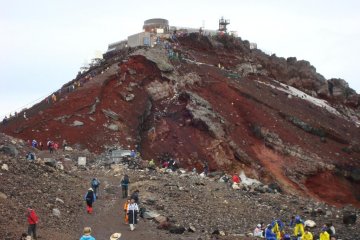Mt. Fuji is calling—and so are the crowds. In 2024 alone, over 204,000 people hiked Mt. Fuji during the official climbing season. However, the surge in independent travelers, especially international tourists, has brought with it serious challenges: overcrowding, unpreparedness, safety risks, and growing strain on the mountain’s delicate ecosystem.
In response to these problems, Shizuoka Prefecture introduces new climbing regulations in 2025 for the Fujinomiya, Gotemba, and Subashiri trails during the climbing season from July 10 to September 10. These changes aim to protect both climbers and the fragile alpine environment of Mt. Fuji.
Why New Rules Are Being Introduced
Officials are increasingly concerned about the dangers posed by unprepared hikers climbing Mt. Fuji. Shizuoka authorities have reported confusion at trailheads, frequent bottlenecks during peak hours, and a growing number of climbers setting out without proper gear or planning. Some even try to make the climb overnight without resting, a risky habit known as “bullet climbing”, that raises the chance of accidents and incidents involving missing persons.
Beyond safety, there are also concerns about a lack of awareness around trail etiquette and local customs. Basic practices such as yielding to uphill hikers, minimizing noise, and properly managing waste are often ignored. Addressing these issues is essential not only for maintaining order on the trails but for preserving the cultural integrity of the mountain itself. As a UNESCO World Heritage Site and a sacred symbol in Japanese culture, Mt. Fuji requires more than just physical preparedness—it requires respect. The new regulations introduced in 2025 aim to support safer, more ethical, and environmentally sustainable climbs for all visitors.

Pre-Climb Requirements
Starting in 2025, all climbers using the Fujinomiya, Gotemba, and Subashiri trails on the Shizuoka side of Mt. Fuji must complete pre-registration through the official SHIZUOKA FUJI NAVI app before their hike. This step is required to help ensure safety, environmental preservation of Mt. Fuji, and that climbers are properly informed.
The SHIZUOKA FUJI NAVI app is available in seven languages and eight scripts and offers essential features including:
- A digital entrance permit
- Live trail and location tracking
- Weather alerts and push notifications
- Trail condition updates and emergency info
- Multi-language support
Every climber is required to complete a short educational module on rules and manners within the SHIZUOKA FUJI NAVI app. This module provides essential guidance on trail safety, environmental protection, and proper climbing etiquette, helping ensure that all hikers understand their responsibilities while on the mountain.
Once the education module is completed, climbers must pay a ¥4,000 entrance fee per person for each climb. This fee contributes to the maintenance of the trails, environmental preservation of Mt.Fuji, and support systems that help keep Mt. Fuji safe and accessible for all.
Additionally, if you’re planning to start your hike between 2pm and 3am, you’ll need to show proof that you’ve booked a stay at a mountain hut. This rule helps prevent dangerous overnight climbs, which are often done without proper rest and can be risky due to darkness, exhaustion, and a higher chance of altitude sickness.
Climbers who skip advance registration will likely face waiting at the trailhead. Not only will you have to complete the on-site safety orientation, but you’ll also need to pay the entry fee then and there—often alongside others in the same situation. These extra steps can easily cut into your hiking schedule, especially during peak season when lines are longer and staff are busier. Using the SHIZUOKA FUJI NAVI app to plan ahead helps you skip the hassle.

At the Trailhead: What to Expect
When you arrive at the trailhead—whether Fujinomiya, Gotemba, or Subashiri—you’ll find staff and clear signage ready to guide you through the check-in process. Each trail has its own characteristics and route-specific safety protocols.
- Fujinomiya Trail: The shortest route to the summit, starting at 2,380m. Entry is restricted between 2pm and 3am without a mountain hut reservation. All climbers must register in advance and pay the mountain entry fee before climbing.
- Gotemba Trail: Starts at the lowest elevation (1,440m) and is the longest route. Less crowded but more physically demanding. Climbers must register and are also restricted from entering between 2pm and 3am unless staying in a hut. Payment of the mountain entry fee is also required.
- Subashiri Trail: Begins at 1,970m and passes through shaded forest terrain before merging with the Yoshida Trail. Same climbing restrictions apply—no entry from 2pm to 3am without a hut booking, and advance registration and payment of the mountain entry fee is mandatory.
Staff are there to help ensure everyone meets these conditions before entering the trail. Be prepared to show your FUJI NAVI app registration and undergo a brief safety review if required.

Safety and Etiquette Tips
A successful Mt. Fuji climb starts with more than just physical preparation. Paying close attention to safety and etiquette helps create a more enjoyable and responsible experience for everyone on the mountain. As you prepare for your ascent, keep these important tips in mind:
- Dress Properly: Choose well-broken-in hiking shoes to avoid discomfort or injury. Weather on Mt. Fuji is unpredictable, so bring proper rainwear—jacket and pants, not a poncho. Temperatures near the summit can drop below freezing even during the summer, so layering with thermals is essential for staying warm and safe.
- Acclimatize at the 5th Station: Rest for at least an hour before starting your hike. This gives your body time to adjust to the altitude, reducing the risk of fatigue, headaches, and altitude sickness.
- Plan with Time in Mind: Always check shuttle bus schedules and allow enough time to return before sunset. Descending in the dark is hazardous, especially on unfamiliar trails.
- Follow ‘Leave No Trace’ Principles: Carry your trash, keep noise levels down, and be considerate of others on the trail. Small actions like these help preserve Mt. Fuji’s environment.

Final Thoughts and Helpful Links
Before officially setting out on your Mt. Fuji adventure, take time to explore official resources that go far beyond general hiking tips. The Mt. Fuji official website is your most reliable source of up-to-date information. It provides updates on weather conditions, trail closures, shuttle bus schedules, and facility availability. You’ll also find emergency protocols, multilingual support for international visitors, and guidance on local customs to help you prepare.
Also worth knowing—Shizuoka Prefecture looks after three of Mt. Fuji’s main trails and works hard to keep them safe with clear rules and helpful support. If you need more information about climbing fees, rules, or how to get in touch, head to Shizuoka’s climbing regulation page.
Remember: reaching the summit is only part of the journey. The way you climb—safely, mindfully, and respectfully—defines the true spirit of Mt. Fuji!











